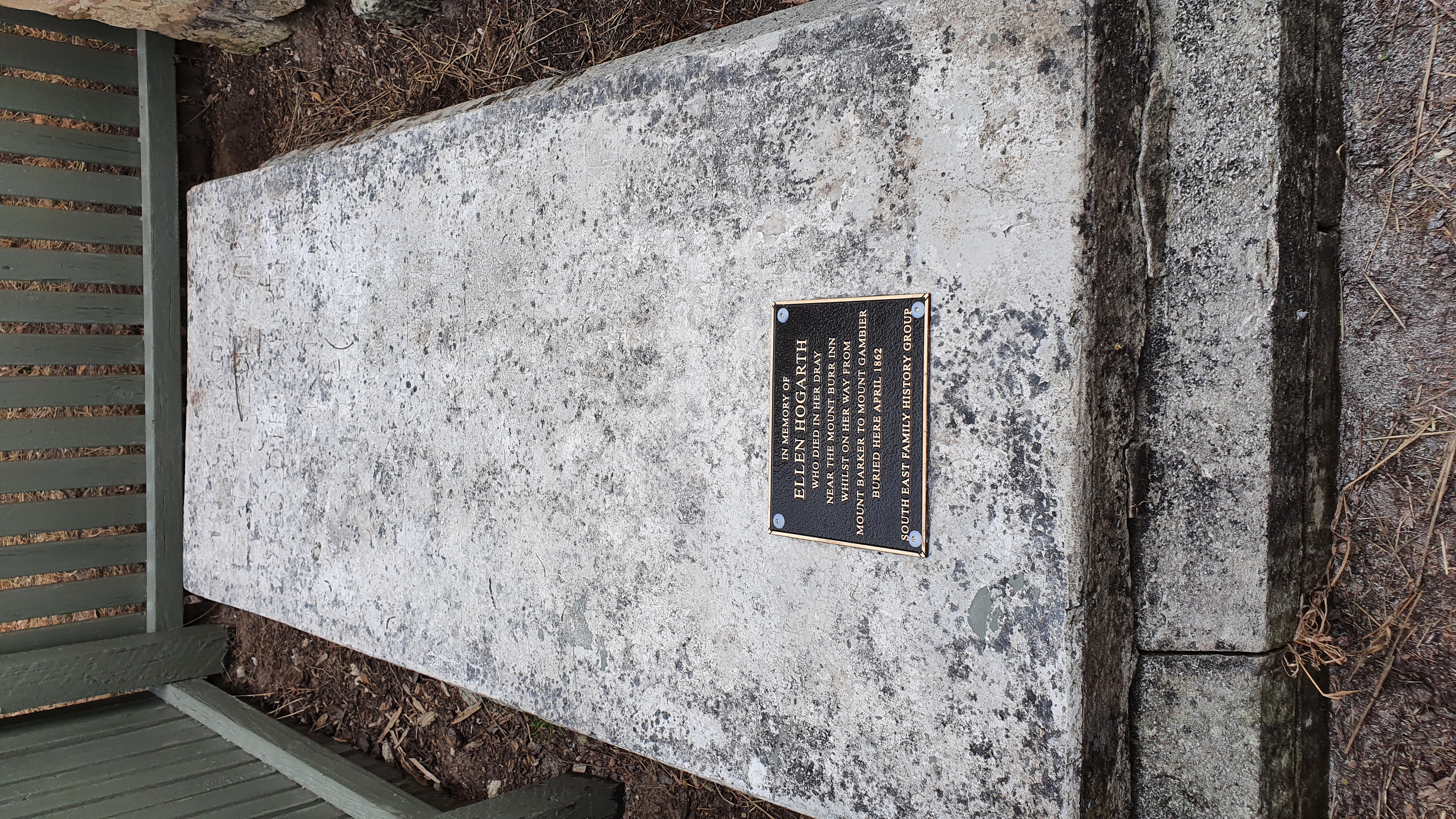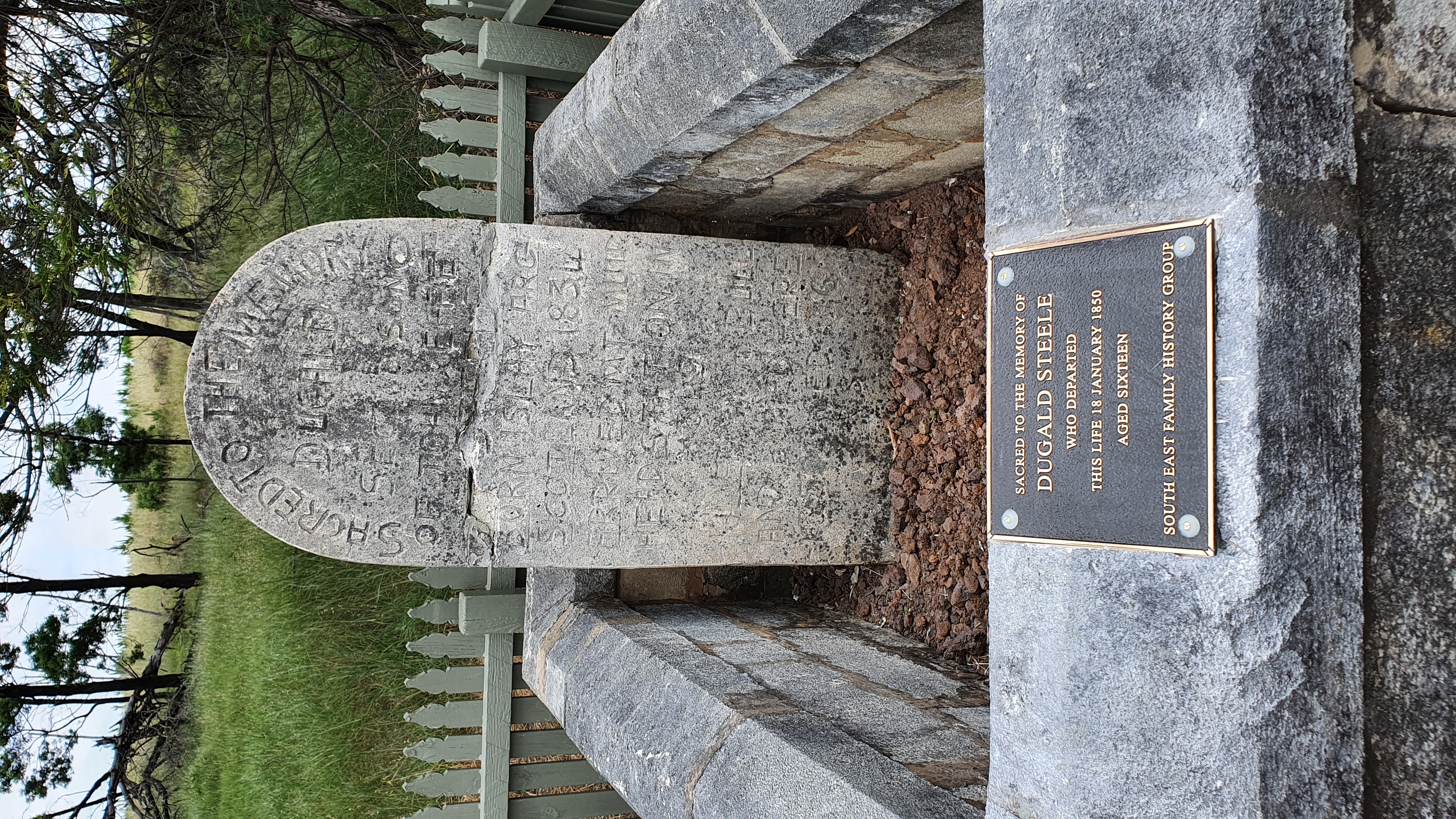Gran Gran Graves – Dugald Steele and Ellen Hogarth
There are two historical graves on the junction of Mount Burr Road and Glencoe Road (the Overland Track) near the outskirts of the township of Mount Burr. The area is called Gran Gran which refers to the Aboriginal name for a cave there.
One of the graves is for Ellen Hogarth and the other for Dugald Steele.
Dugald Steele
An early written recording of a grave at Gran Gran is in the journal of G. E. Morrison called “The Long Walk”. This publication recorded the adventure of a young George Ernest Morrison (later known as Chinese Morrison in light of his work as a newspaper correspondent in China) when he walked from Queenscliff(e) in Victoria to Adelaide (a distance of almost 1000 kilometres) in 46 days during the summer of 1879 -1880.
On Friday 30 January 1880 Morrison visited the grave and wrote in the margin of his diary. “Sacred to the memory of Dugald Steele who departed this life 18 January 1850 age sixteen.”


In the 1970’s, local historian and stone mason, Bruce Towers, restored the grave of Dugald Steele and erected a slab for Ellen Hogarth and placed a large wall around both of the graves. A picket fence was also erected.
On the new headstone for Dugald, Bruce inscribed: “Sacred to the Memory of Dugald, Second Son of John & Effie Steele, Born Islay Arg Scotland 1834. Arrived Mt Muirhead Station in 1849. Killed by a bull and buried here age 16 years”
The cause of death is a matter of some conjecture. A letter in the Mount Gambier newspaper, The Border Watch, on 17 January 1931, from Thomas McCourt of Millicent, repeats a story told to him by a relative 30 years previously. “On the journey out by a sailing ship, Dugald contracted Influenza then known as fog fever. He never recovered and died a few months after arriving at Mount Muirhead. Mr Archibald Johnson accorded his youthful employee a respected burial. The grave being stone lined with a heavy slab bearing a suitable inscription.”
This was refuted in a later edition by Roland Campbell, a former editor of the Millicent newspaper, The South Eastern Times, who wrote that it was a long held belief, as a result of stories told by old stockmen of the area, that Dugald had been gored by a bull.
As there was not a death certificate issued, Dugald’s cause of death can not be proved.
However, it appears his time in South Australia was short as Dugald arrived on 26 December 1849 at Adelaide aboard the ship ‘Harry Lorrequer’ with his parents, John & Isabella Steele, his four brothers and one sister. As he died on 18 January 1850 he had only three weeks in his newly adopted country.
Ellen Hogarth
When G.E. Morrison visited the grave of Dugald Steele he did not mention the grave of Ellen Hogarth. Perhaps the grave was not visible or there was not an inscription.
The only mention found is in the Border Watch of 9 May 1862 which gives a report on Ellen’s death.
“Melancholy death, - We had more than one instance of sudden death in our district: and the following is somewhat distressing narrative. It seems that a young woman named Ellen Hogarth about 22 years of age, on her way from Mount Barker to Mount Gambier, arrived at Mount Muirhead on the evening of the 29th April. She complained a little that evening of biliousness, to which she was subject. Mrs Brown supplied her with restorative, which served to relieve her. She slept well during the night, but became worse in the morning and died in the dray when about 2 miles on the road. Her body was conveyed to Mount Burr public house. Notice was sent to the police, and Sergeant Young proceeded to Mount Burr, gave notice to the coroner, and summoned a Jury of nine. Dr Wehl made a post mortem examination, the result of which concurred with evidence, and the jury returned a verdict of ‘Died from disease of the heart’. The Jury added a rider to the verdict, to the affect that no blame was attributed to the parties with whom she was travelling.”
